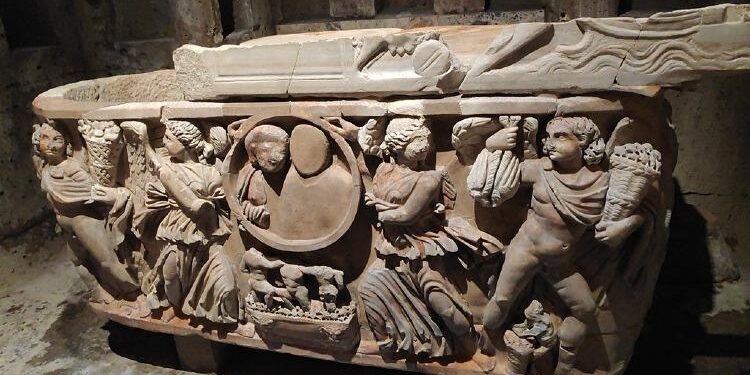Archaeologists have uncovered the tomb of a wealthy ancient Roman individual in Albania, shedding new light on the region’s historical significance during the Roman era. The discovery, announced by local authorities and detailed in a Reuters report, provides valuable insights into the burial practices and social hierarchy of the period. This find not only highlights Albania’s rich archaeological heritage but also offers a glimpse into the lives of the elite in ancient Roman society.
Wealthy Ancient Roman Tomb Unearthed in Albania Sheds Light on Imperial Era
Archaeologists in Albania have uncovered a remarkably well-preserved Roman tomb that dates back to the height of the Imperial era, offering fresh insights into the wealth and social dynamics of the period. The burial site, located near the ancient city ruins of DurrĂ«s, contained a variety of grave goods that indicate the occupant’s high status within Roman society. Among the findings were intricately designed jewelry, bronze utensils, and luxury pottery, all pointing to the tomb belonging to a prosperous individual, possibly a local noble or merchant integrated within the Roman imperial system.
Excavation teams revealed several unique features of the tomb, including:
- Elaborate frescoes depicting mythological scenes
- A carved marble sarcophagus with Latin inscriptions
- Coins from multiple emperors, suggesting long-term use or prestige
These artifacts offer a rich narrative of life under Roman rule in the region and contribute valuable data to the understanding of Albania’s role as a significant provincial hub during the empire’s expansion. Archaeologists plan further analysis that may reveal more about trade routes and cultural exchanges in the Balkans.
| Artifact | Description | Significance |
|---|---|---|
| Bronze Necklace | Gold-inlaid with precious stones | Indicative of wealth and craftsmanship |
| Coins | From Emperor Trajan to Marcus Aurelius | Suggests prolonged occupation or reverence |
| Frescoes | Depictions of Roman gods and heroes | Reflects cultural and religious beliefs |
Archaeological Findings Reveal Luxurious Burial Practices and Cultural Significance
Excavations have uncovered a remarkable tomb belonging to a wealthy Roman individual, shedding light on the opulent burial customs practiced in ancient Albania. The site features lavish grave goods, including intricately designed jewelry, finely crafted pottery, and ornate metalwork, indicative of high social status. Such findings suggest that affluent Romans in the region embraced elaborate funerary rituals as a means to display wealth, power, and cultural identity even in death.
The artifacts also reveal broader societal values and connections across the Roman Empire. Notable discoveries include:
- Gold and silver coins, pointing to economic prosperity and trade networks
- Imported ceramics, highlighting cultural exchange with Mediterranean hubs
- Engraved gemstones, likely used as amulets to protect the deceased in the afterlife
| Artifact | Description | Material |
|---|---|---|
| Necklace | Elegant chain with clasp | Gold |
| Amphora | Decorated vessel for oils | Ceramic |
| Coin | Emperor’s portrait | Silver |
Experts Recommend Enhanced Preservation and Expanded Excavations to Protect Heritage
Archaeologists and heritage specialists stress the urgent need for advanced conservation techniques following the discovery of a wealthy Roman burial site in Albania. The site’s intricate mosaics and well-preserved artifacts are highly vulnerable to environmental factors and human interference. Experts advocate for the immediate installation of protective coverings and climate control systems to safeguard the tomb’s original features, ensuring that future generations can appreciate the cultural and historical value embedded within this significant find.
Beyond preservation, specialists recommend expanding excavation efforts to uncover additional remains and artifacts surrounding the tomb. This approach would provide a more comprehensive understanding of the social and economic stature of the individual interred and shed light on burial practices in ancient Roman Albania. Proposed measures include:
- Systematic site mapping and use of non-invasive ground-penetrating radar
- Collaborative research involving international experts in Roman archaeology
- Community engagement programs to raise awareness and protect the site
| Preservation Measures | Expected Benefit |
|---|---|
| Protective Canopy Installation | Reduces weathering and erosion |
| Temperature & Humidity Controls | Maintains artifact integrity |
| Digital 3D Documentation | Enables virtual study and public access |
Future Outlook
The discovery of the wealthy ancient Roman’s tomb in Albania offers a rare glimpse into the region’s rich historical tapestry and its connections to the Roman Empire. As archaeologists continue to study the site, further insights are expected to emerge, shedding light on the lives of the elite in antiquity. This finding not only underscores Albania’s significance as a historical crossroads but also promises to deepen our understanding of ancient Roman culture and influence in the Balkans.
















